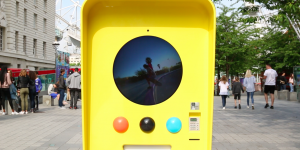Accepting that consumers are no longer willing to wait for a reward, Nectar is for the first time experimenting in the realm of instant gratification as it looks to eke out more value in its currency.
Along with its loyalty scheme competitors, Nectar was designed to encourage patience in the form of steady, accumulative spending gains. But now that consumer loyalty has a new face – one that’s hungry for instant gratification – the brand has realised that it needs to add more and more value to its currency if it's to stay relevant in an age of immediate and ubiquitous rewards.
James Moir, Nectar's managing director of eight months, is well-versed on what he needs his business to do. Having spent nearly a decade of his career at parent company Aimia, he's come to the table with a number of new objectives: bringing new brands on board to expand its list of 19 redemption and issuance partners that now includes Photobox and the Daily Mail, educating its customers about the hundreds of affiliate companies it works with online, and growing its base of younger customers to name a few.
But for all the new partnerships and plans to bring in a new consumer base, everything it’s doing comes down to anticipating the future of loyalty, and banking the relevance and value of Nectar as a currency. And, on that front, it's still got work to do.
“There's a lot of talk around how loyalty is changing, and how customer expectations are changing, but exactly what they're changing to…I don't think we know the answer to that yet,” admitted Moir.
“But from the research we've done, we know that value is as important as it's ever been. Facing into the next few years in a post-Brexit world, people generally feel a little unnerved. More customers say they feel worse off than they did a year ago."
According to Nectar, 50% of consumers say that they're going to have to rein some of their spending in and another 20% say they’re going to actually cut back.
"So value is as important as ever being, and loyalty cards play a really important role in that. But we're not blind, customer expectations are changing," Moir said.
A big part of this change pivots around the time-sensitive nature of rewards. Most businesses – not just in the world of loyalty – are now seeking to claim the holy grail of instantaneity: money, mail, taxis, food and so on can all be ordered and delivered immediately. This is coupled with consumers’ addiction to small, serotonin hits earned every time they check their phones and means they expect loyalty rewards to be instant too. Which is a problem for a business built on the premise of slow but steady spending.
The obvious solution would be to physically put something in cardholder’s hands when they enter the shop. But as the guinea pig of this method, Waitrose proved this isn’t always a sustainable road for a business to go down. Its no strings, free coffee for every myWaitrose card holder offer didn’t seem to generate the in-store spend it anticipated and it was forced to curb the offering earlier this year, with customers now having to make a purchase before picking up a cup. At the same time, Waitrose raised the minimum spend of its free newspaper offer from £5 to £10. Yet if the scheme was no more than lure to get people to sign up to myWaitrose, it might have done its job: in 2015 the grocer claimed that 70% of its sales were made using the loyalty card.
Meanwhile, Tesco Clubcard, the granddaddy of loyalty schemes, is also developing what it's offering customers. "We have made some changes over the last year to our scheme," a spokesperson told The Drum. "And will continue to do so in the coming months to make it easier to use and simpler to understand."
What these changes will look like is unclear at the moment, however the supermarket is currently promoting its Clubcard Partners such as Café Rouge, Thorpe Park and the RAC, through which customers can increase the value of their rewards (for instance £2.50 in Clubcard vouchers can be traded in for £10 to spend at Zizzi). This is part of the Boost programme, which like Nectar, aims to offer consumers greater utility.

As a multi-brand loyalty scheme, Nectar’s ability to hand out freebies becomes more complicated, purely because they don’t own anything tangible to hand out at will. So instead, Moir has been experimenting with point of sale, swipe-to-win campaigns.
“You swipe your card and you’ll be entered into a draw there will be X number of chances to win extra points – it can be one in five, one in two, sometimes one in one,” he said. “We did one with Sainsbury’s before Christmas where every customer got something. The minimum was 200 points and you could earn up to 50,000 points. That was a nice combination because it gave [customers] something here and now, but also helps them save for the long term.”
In another shift, Nectar said it's also considering linking with its partners to offer a physical product as a reward.
“Points will always be a big part of what we are … but being able to win products as well is absolutely something that we're thinking about,” said Moir. “It ultimately comes down to what an individual customer would like.”
With a stack of historical data to sift through, understanding Nectar’s 20 million customers has been a cornerstone of Moir's work since he arrived back from sister agency I2C at the end of last year. Before his return the brand launched a wide-reaching campaign to promote the digital side of its business – itself a tactic to speed up the rate rewards reach consumers – but as a marketer, Moir soon realised that “not everyone wants to be spoken to digitally”.
He explained: “I think we are sometimes, in this industry, a little bit guilty of thinking everyone wants to use a smartphone. Of course that that's actually not the case. So ensuring we are always as relevant as we should be to all of our customers is critical. It's a learning for all marketers – you’ve got to really know your customer deeply.”
In the same vein, Moir has ruled out eliminating the physical Nectar Card – for now.
“We could say: ‘Right, no physical cards anymore’, you've got to have a digital card. And I would say that will probably appeal to 10% of our customers.”
As Nectar moves from coupons in the post to instant gratification, personalised email campaigns, an app and a growing base of online affiliates, it’s clear Moir and the company are by no means resting their laurels on the brand’s early success in the early 00s. Cardholder growth is still important to the marketing team despite its already huge customer base, while partnership development is key to making sure consumers stick with the brand as its currency becomes more usable, and therefore more valuable.
In the past year six months Nectar has been trialing working with sole, independent traders and its Daily Mail deal proves it’s serious in its ambitions to touch upon every area of consumer spending.
“We probably cover something like two thirds of a typical household spend,” said Moir. “We want to make it up to 100%.”



















